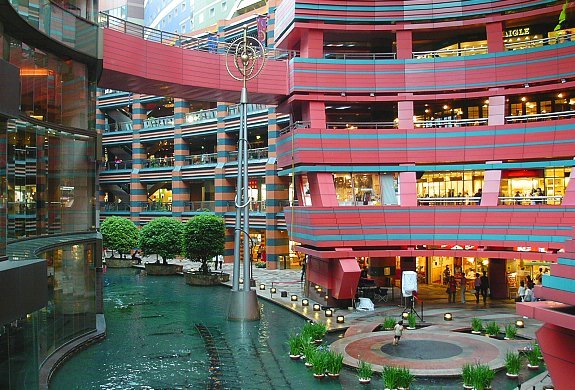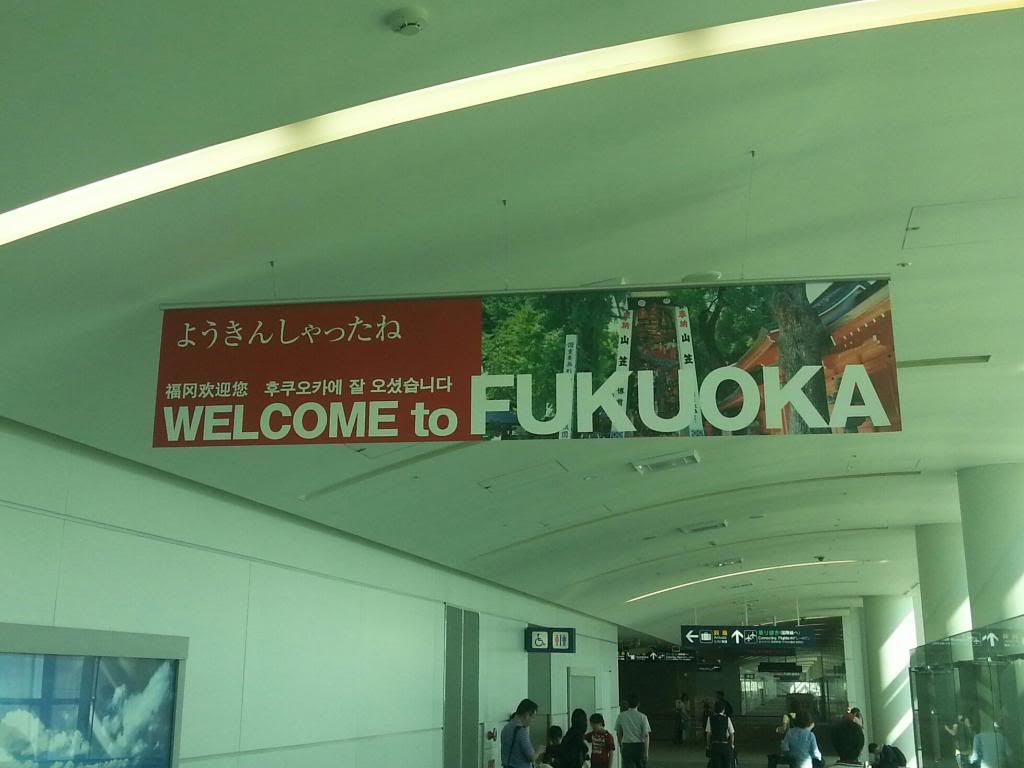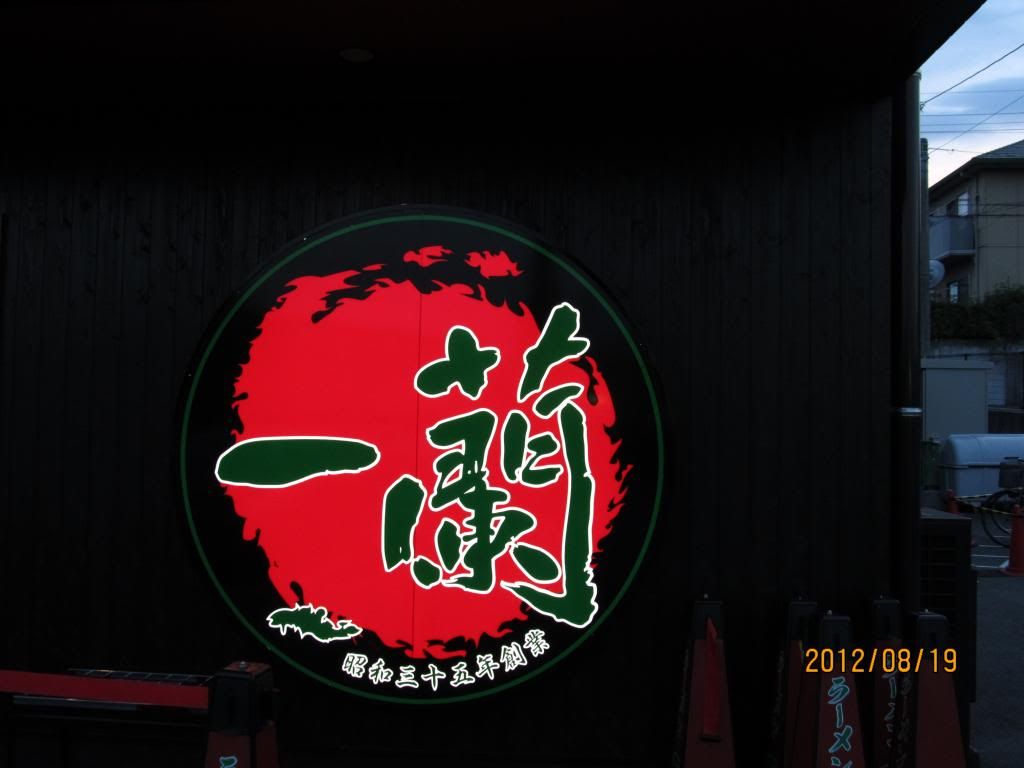This is an article I’ve been working on for FukuokaJET.com, a resource website made for JETs living in Fukuoka prefecture, especially new recruits. The information here focuses on Fukuoka, but I think it’s a fairly good survey of the major ramen styles for anybody who’s interested.

Tonkotsu (Pork Bone) 豚骨・�ん��
Tonkotsu ramen is the richest of the four main ramen broth varieties, and the ramen for which Fukuoka is famous. The greyish white soup is made by boiling pork bones, fat, and collagen over high heat for hours on end, suffusing the broth with a hearty pork flavor and a creamy consistency that rivals milk or melted butter or gravy (depending on the shop). Most shops, but not all, blend this pork broth with a small amount of chicken and vegetable stock and/or soy sauce. The original tonkotsu ramen, from Kurume, actually has a small amount of powdered bone and marrow in the broth, giving it an even stronger pork taste, chalky texture, and characteristic “stink.” Hakata-style tonkotsu generally does not contain bone and is characterized by thin, straight noodles that can be ordered to the firmness of your choice. Another characteristic of tonkotsu ramen shops in the Fukuoka area is kaedama 替玉, an extra helping of noodles that customers can order after they’ve slurped away the original serving. Typical tonkotsu toppings include red pickled ginger, green onions, and tree ears, along with the standard chÄ�shÅ« (sliced pork). Some shops also provide customers with minced garlic or even whole garlic cloves and garlic presses so they can give their soup the freshest garlic flavor possible. Currently the latest trend in tonkotsu toppings is mÄ�yu マー油, a blackish, aromatic oil made from charred crushed garlic. As ingredients and methods vary from shop to shop, it is said that no two bowls of Hakata ramen are alike, so try as many as you can!
Many of Hakata’s ubiquitous yatai 屋å�° (street stalls) sell tonkotsu ramen, often with side dishes like gyoza and fried rice. Yatai advertising Nagahama 長浜 ramen are some of the most popular, as the Nagahama style – named for the working-class area northwest of Tenjin – is a bit lighter than basic Hakata ramen.
Where to try it in Fukuoka:
IppÅ«dÅ� (Original DaimyÅ� Shop) ä¸€é¢¨å ‚å¤§å��本店
Fukuoka City Chū�-ku Daimy� 1-13-14
092-771-0880
11:00-02:00, Sundays and holidays 11:00-24:00
Recommended ramen: Akamaru Kasane-aji 赤丸ã�‹ã�•ã�味 (¥800), Kiwami Shin’aji 極新味 (¥1300)
Isshin Furan 一心�乱
(Original Shop)
Fukuoka City Chū�-ku Daimy� 2-6-5
Tenjin Nishi-d�ri-kan 1F
092-733-3768
11:00-02:00, Sundays and holidays 11:00-24:00
(Canal City Shop)
Fukuoka City Hakata-ku Sumiyoshi 1-2
Hakata Canal City 5F, Ramen Stadium
092-271-5166
11:00-23:00
Recommended ramen: Kuro no Koku Tonkotsu Ramen é»’ã�®ã‚³ã‚¯ã�¨ã‚“ã�“ã�¤ãƒ©ãƒ¼ãƒ¡ãƒ³ (¥600)
TaihÅ� å¤§ç ²
(Original Shop)
Kurume City T�rihoka-machi 11-8
0942-33-6695
11:00-21:00; closed every second and fourth Thursday of the month
(Tenjin Imaizumi Shop)
Fukuoka City Chū�-ku Imaizumi 1-23-8
093-738-3277
11:00-23:00
Recommended ramen: Ramen ラーメン (¥480), Mukashi Ramen 昔ラーメン (¥500)
T�y�ken �洋軒
Kitakyushu City Kokurakita-ku Kogane-machi 1-4-30
093-931-0095
11:00-15:00, 16:00-21:30; closed Wednesday
Recommended ramen: Wantan-men ワンタンメン (¥700)
Ajisen 味�拉麺
Fukuoka City Higashi-ku Hakozaki 5-1-8
Rakuichi Kaid� Shopping Center
092-632-6212
11:00-02:00; Friday and Saturday 11:00-03:00
Recommended ramen: PaikÅ«-men パイクー麺 (¥850)

ShÅ�yu (Soy Sauce) 醤油・æ£æ²¹ãƒ»ã�—ょã�†ã‚†
ShÅ�yu ramen is the most traditional variety, with its roots in the Chinese immigrant community of Yokohama. The broth is typically brown and clear, based on a chicken and vegetable (or sometimes fish or beef) stock with plenty of soy sauce added for a soup that’s tangy, salty, and savory yet still fairly light on the palate. ShÅ�yu ramen usually has curly noodles rather than straight ones, but this is not always the case. It is often adorned with marinated bamboo shoots (menma 麺媽), green onions, kamaboko (fish cakes), nori (seaweed), boiled eggs, bean sprouts and/or black pepper; occasionally the soup will also contain chili oil or Chinese spices, and some shops serve sliced beef instead of the usual chÄ�shÅ«. ShÅ�yu ramen is ubiquitous around Tokyo and Yokohama, but in Fukuoka it is not as popular as the hometown favorite, tonkotsu. Still, there are several shops across the prefecture that serve a good bowl of shÅ�yu ramen – some richer than usual to cater to local tastes.
Where to try it in Fukuoka:
Fuji� 藤王
Kitakyushu City Kokurakita-ku Uo-machi 2-4-18
New Fukusuke Building 2F
093-511-2800
11:00-20:00 (last order 19:30); closed every third Wednesday of the month
Recommended ramen: ChÅ«ka Soba ä¸è�¯ã��ã�° (¥530)
RanshÅ« è˜å·ž
Kitakyushu City Kokurakita-ku Furusenba-machi 5-21-103
093-531-6999
11:30-14:00, 19:00-24:00; closed Sunday and closed for lunch on Wednesday
Recommended ramen: Yakuzen Ramen 薬膳ラーメン (¥500)
ChÅ«ka Soba GÅ�ya ä¸è�¯ã��ã�°éƒ·å®¶
(Original Shop)
Fukuoka City Minami-ku Terazuka 1-26-7
092-541-0266
11:00-20:30 or until the soup is gone, Sundays and holidays 11:00-20:00; closed Wednesday or the following day if Wednesday is a holiday
(Tenjin Shop)
Fukuoka City Chū�-ku Watanabe-d�ri 5-25-11
092-713-1333
11:00-23:00, Sundays and holidays 11:00-22:00; closed Wednesday
Recommended ramen: Karanegi Ramen è¾›ã�ã�Žã‚‰ãƒ¼ã‚�ã‚“ (¥650)
MengekijÅ� Gen’ei éººåŠ‡å ´ã€€çŽ„ç‘›
Fukuoka City Chū�-ku Yakuin 2-16-3
092-732-6100
11:30-14:30, 18:00-24:30, Sundays and holidays 11:30-22:00
Recommended ramen: (Ushio-kaori) ShÅ�yu Ramen (潮薫)醤油拉麺 (¥800)

Miso 味噌・��
Miso is a fairly recent development in ramen soup, a specialty of Hokkaido and northern Honshu that originated in the 1970s. Those familiar with miso soup from instant soup packets or sushi bars may expect miso ramen to be fairly light and healthy, but actually miso is second only to tonkotsu in terms of richness. Copious amounts of miso are blended with oily chicken or fish broth – and sometimes with tonkotsu or lard – to create a thick, nutty, slightly sweet and very hearty soup. Miso ramen broth tends to have a robust, tangy flavor, so it stands up to a variety flavorful toppings: spicy bean paste (tÅ�banjan 豆æ�¿é†¤), butter and corn, leeks, onions, bean sprouts, ground pork, cabbage, sesame seeds, white pepper, and chopped garlic are common. Noodles are typically thick, curly, and slightly chewy.
Where to try it in Fukuoka:
Sumire ��れ
Fukuoka City Chū�-ku Imaizumi 1-3-1
TY Building Imaizumi 2F
092-741-4685
11:30-23:00; closed Tuesday
Recommended ramen: Miso Ramen 味噌ラーメン (¥780)
Hakata Mendokoro Takadaya �多麺処 高田家
Fukuoka City Chū�-ku Yakuin 2-2-28
092-716-0670
11:00-02:00 (last order 1:30), Sundays and holidays 11:00-23:00
Recommended ramen: Kogashi Miso Ramen 焦ã�Œã�—味噌ラーメン (¥800), Miso Butter Corn Men 味噌ãƒ�ターコーン麺 (¥850)
Kawabata Dosanko �端��ん�
Fukuoka City Hakata-ku Kamikawabata-machi 4-229
092-271-5255
11:15-19:55; closed Tuesday and every third Monday of the month
Recommended ramen: Tokusei Miso Ramen 特製味噌ラーメン (¥600)

Shio (Salt) 塩・��
Ubiquitous in southern Hokkaido and Niigata but rare in Fukuoka, shio is the lightest ramen out there, a pale, clear, yellowish broth made from plenty of salt and any combination of chicken, vegetables, fish, and seaweed. Occasionally pork bones are also used, but they are not boiled as long as they are for tonkotsu ramen, so the soup remains light and clear. Shio is generally the healthiest kind of ramen; fat content tends to be low, and fresh vegetables like cabbage, leeks, onions, and bamboo shoots typically adorn the simple soup and curly noodles. Ch�shū is sometimes swapped out for lean chicken meatballs, and pickled plums and kamaboko are popular toppings as well. However, some shops do add lard or oil to make the broth richer or offer a topping of butter and corn for a popular and similarly bad-for-you variation. Noodle texture and thickness varies among shio ramen, but they are usually straight rather than curly.
Where to try it in Fukuoka:
Shionoya ��や
Fukuoka City Hakata-ku Hakata Station Chū�gai 6-12
Yodobashi Camera 4
092-432-8171
11:00-22:30
Recommended ramen: Shio Ramen 塩ラーメン (¥600), Tokusei Shio Ramen 特製塩ラーメン (¥850)
Menya-sanshi 麺8−34
Kitakyushu City Kokurakita-ku Muromachi 2-11-5
093-571-6634
11:30-16:00, 18:00-21:00; closed Tuesday
Recommended ramen: Shio Ramen 塩ラーメン (¥500), Tori Paitan é¶�白湯 (¥500)
Neo-Ramen �オラーメン
Recently, chefs across the country have been getting increasingly creative with ramen. Some chefs play around with different kinds of broth, some employ unusual ingredients or cooking methods, and some simply push the limits of richness, flavor, and volume. These new ramen experiments are often called “neo-ramen” and include innovations such as: curry ramen, burnt ramen, black miso ramen, motsu ramen, chanpon-style ramen, yakisoba-style ramen, tonkotsu-fish stock blends, chili-infused noodles, and toppings like fried chicken, gelled pork broth, grilled chÄ�shÅ«, pork cutlets, pork collagen, shellfish, shark fin, yuzu peel, chawan mushi, and cheese. Some neo-ramen offerings are simply weird, but many are pleasantly surprising and genuinely delicious.
Where to try it in Fukuoka:
Gogy� 五行
Fukuoka City Chū�-ku Imaizumi 1-18-26
092-735-4152
11:30-02:00; Sundays and holidays 11:30-01:00
Recommended ramen: Kogashi Miso Men 焦ã�Œã�—味噌麺, Kogashi ShÅ�yu Men 焦ã�Œã�—醤油麺 (¥850 each, ¥1000 during dinner hours)
Chururu Chu-ra �ゅるる�ゅーら
Kitakyushu City Yahatanishi-ku Satonaka 1-6-10
093-611-2666
11:30-22:00, Tuesday until 15:00
Recommended ramen: Tonkotsu Otoko-aji ChÄ�-churu Hige-jÄ« 豚骨男味ãƒ�ャーã�¡ã‚…るヒゲã�˜ã�„ (¥950), Gyokai Tonkotsu Aka-mÄ�yu Churu-chura éšä»‹è±šéª¨èµ¤ãƒžãƒ¼æ²¹ã�¡ã‚…ã‚‹ãƒ�ュラ (¥600), Gyokai Tonkotsu Churu-chura éšä»‹è±šéª¨ã�¡ã‚…ã‚‹ãƒ�ュラ (¥600)
Fūgen 風玄
Kitakyushu City Yahatanishi-ku Yatsue 5-3-18
093-691-1141
11:00-23:00
Recommended ramen: Tomato Ramen with Garlic Toast ã�¨ã�¾ã�¨ãƒ©ãƒ¼ãƒ¡ãƒ³ã‚¬ãƒ¼ãƒªãƒƒã‚¯ãƒˆãƒ¼ã‚¹ãƒˆä»˜ (¥750), Yahata Red 八幡レッド (¥700)
Menmi 麺美
Kitakyushu City Moji-ku Minato-machi 5-1
Kaiky� Plaza East Building 1F
093-321-3020
11:00-20:00
Recommended ramen: Crab Ramen ã�‹ã�«ãƒ©ãƒ¼ãƒ¡ãƒ³ (¥1000), Mentaiko Ramen 明太å�ラーメン (¥1000)
La-men House Sh�maru LA-麺HOUSE 将丸
Fukuoka City Chū�-ku Maizuru 1-8-2-1
092-714-3939
11:30-14:00, 19:00-03:00
Recommended ramen: Kuro La-men é»’LA-麺 (¥550), Wa La-men å’ŒLA-麺 (¥550), ShÅ�maru SP 将丸SP (¥950)

Hiyashi ChÅ«ka, Reimen, and Tsukemen 冷やã�—ä¸è�¯ã€�冷麺ã€�ã�¤ã�‘麺・ã�¤ã�‘ã‚�ã‚“
To attract more customers during the sweltering summer months, many ramen shops offer chilled noodle dishes called hiyashi chÅ«ka, reimen, or tsukemen. Hiyashi chÅ«ka and reimen (literally “chilled Chinese” and “cold noodles,” respectively) are blanket terms for any cold noodle dish, but they usually refer to a ramen-like cold soup of noodles and fresh vegetables in a thin, usually soy sauce-based broth. Tsukemen specifically refers to a salad-like dish inspired byzaru soba (cold buckwheat noodles) consisting of cooked, cold noodles, julienned chÄ�shÅ«, vegetables, and egg that customers dip in a cold sauce, often based on the shop’s ramen stock. Cold noodles are usually available starting in May or June until the end of September, but some ramen shops sell them year round; many Korean restaurants are also reliable sources for tasty, refreshing reimen.












 Hakata port as a base of Japan-China trade, the shrine was built on the emperor’s order to share a god with Kushida shrine of Ise province (the present Mie prefecture).
Hakata port as a base of Japan-China trade, the shrine was built on the emperor’s order to share a god with Kushida shrine of Ise province (the present Mie prefecture).